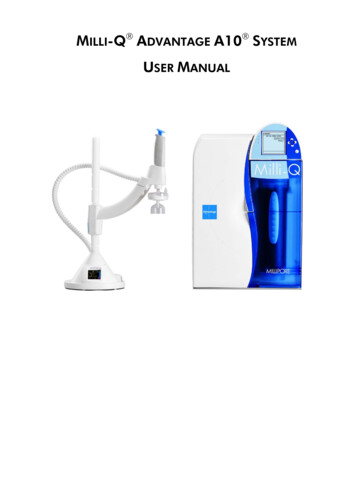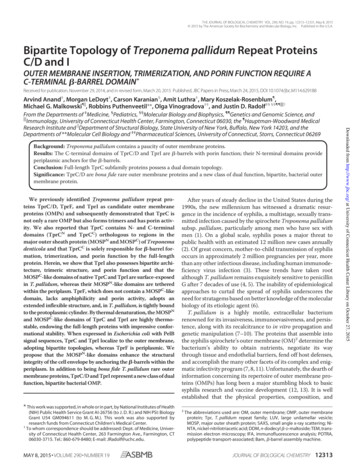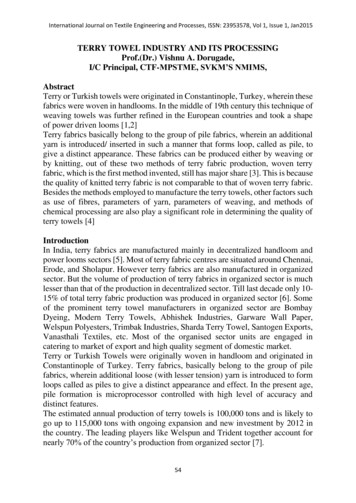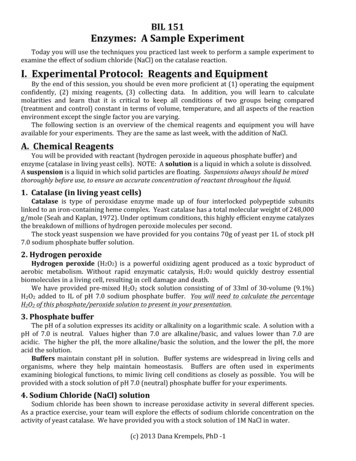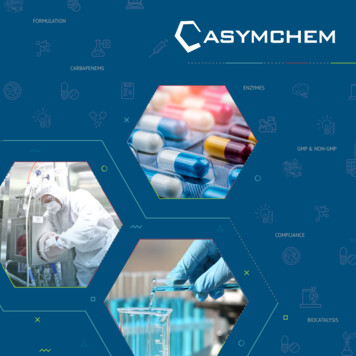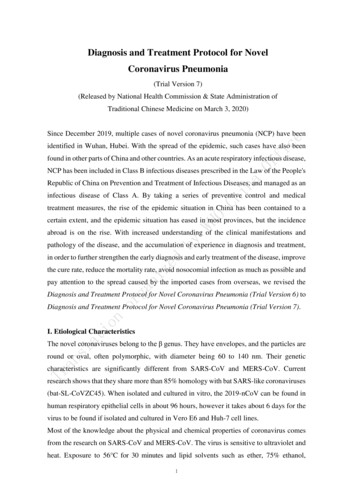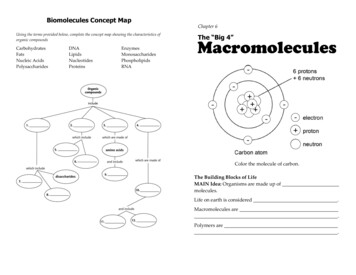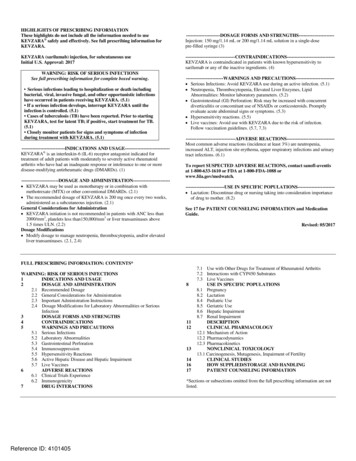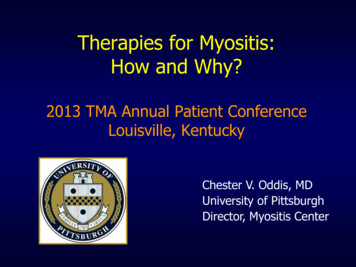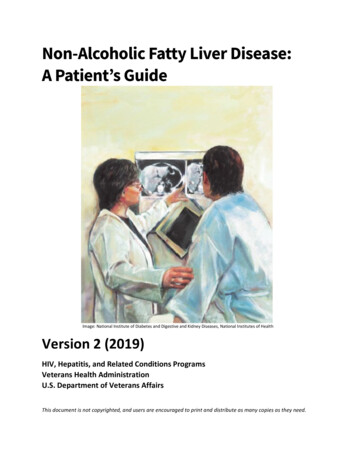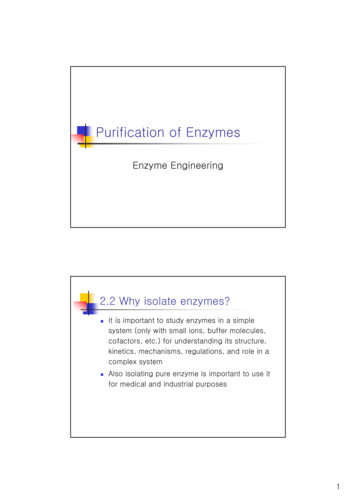
Transcription
Purification of EnzymesEnzyme Engineering2.2 Why isolate enzymes? It is important to study enzymes in a simplesystem (only with small ions, buffer molecules,cofactors, etc.) for understanding its structure,kinetics, mechanisms, regulations, and role in acomplex systemAlso isolating pure enzyme is important to use itfor medical and industrial purposes1
2.3.1 Objectives of enzyme purification Objectives : maximum possible yield maximumcatalytic activity maximum possible purity Assay procedure (Chapter 4) History Crystallization Homogenization large scale separation Attach the affinity tag to enzyme using DNArecombinant technology (ex. (His)6-tag)2.3.2 Strategy2
2.4 Choice of Source Classical approach involves choosing a sourcecontaining large quantity of enzymes Acetyl CoA carboxylase (mammary gland)Alkaline phosphatase (kidney)Modern approach with DNA recombinanttechnology 3-phosphoshikimate-1-carboxyvinyl transferase in E.coli (1984) 100-fold increase in productivityProkaryotes as host organisms (E. coli andBacillus) Rapid growth and simple medium componentsDisadvantages: lack of post-translational modification(glycosylation) and forming inclusion bodies2.4 Choice of Source Yeasts as enzyme source Insect cell with baculovirus vector Saccharomyces cerevisiae rarely forms inclusion bodies,but grow slowly and make hyperglycosylationKluyveromyces lactis and Pichia pastoris are also beingdevelopedIt can employ many of the protein modification,processing, and transport system in higher eukaryoticcells‘Fusion Protein’ Glutathione-S-transferase, maltose binding protein, orHis-tag are popularly usedThey greatly enhance the power of purification andsometimes solubility of protein3
2.4 Choice of Source Production occurred in the strain known to makethe enzyme of interest alkaline protease or α-amylase - Bacilluslicheniformis, glucoamylase - Aspergillus, acid cellulase - Trichoderma, glucose/xylose isomerase - Streptomyces2.5 Methods of homogenization Mechanical methods Non-mechanical methods High pressure homogenizer* (55 MPa) : cooling isimportantWet grinding by mills or glass ballsDryingLysis by osmotic shock, detergents, or enzymesUltrasound*Cooling and protease inhibition are importantto recover the enzyme4
2.5 Methods of homogenization Animal cells (organs) Bacteria and Fungi Cell wall must be digested by enzymes (Protoplasts canbe made by treating lysozyme or chitinase/3-glucanase)Plant It is easy to homogenize due to the lack of cell wallFat and connective tissue must be removed beforehomogenizationDisruption of vacuole can damage enzymesMembrane proteins Usually detergent (anionic, cationic, or neutral) is addedDetergent must be chosen by considering the choice ofpurification method, especially column chromatography2.6 Methods of separation1. Size and mass Ultracentrifugation (300,000g) Sephadex, Bio-Gel P, Sephacryl, and Sepharose –expensive and time-consumingUsually in later stage of purificationDialysis (Mr tens of thousands) Not very efficient to separate a enzyme from enzymepool : Usually used to remove impuritiesGel filteration (Mr hundreds of thousands) Mr is the major factor for separationUsually used for removing salts, organic solvents, etc.Ultrafilteration Small molecules are filtered out by pressureUsed for concentrating proteinsAlternatively, centrifugation with dialysis membrane5
2.6 Methods of separation2.6 Methods of separation2. Polarity Ion-exchangechromatography Electrostatic propertyFlow through in low saltand at appropriate pHDesorption by changingsalt conc’ and pHEnzymes can beseparated by gradientconditionLarge scale is possibleUsually 10-foldincrease in purity6
2.6 Methods of separation2. Polarity Electrophoresis Separation by movement of charged moleculesCapillary electrophoresis (cross section less than100µm)Isoelectric focusing2.6 Methods of separation2. Polarity Hydrophobic interaction chromatography Depending on the nonpolar amino acid on the surface ofenzymeOctyl- or phenyl-Sepharose with high ionic strengthDesorption by lowering ionic strength or adding organicsolvents (or detergents)7
2.6 Methods of separation3. Solubility Change in pH Enzymes are least soluble at pI because there is norepulsive force between enzymesEnzyme must not be inactivated in a range of pHChange in ionic strength Large charged molecules are only slightly soluble in purewater; Addition of ion promotes solubility (Salting in)Beyond a certain ionic strength, the charged moleculesare quickly precipitated (Salting out)Ammonium sulfate is popularly used10-fold increase in purityFructose-bisphosphate aldolase from rabbit muscle canbe purified in high purity by ammonium sulfate2.6 Methods of separation3. Solubility Decrease in dielectric constant Addition of water-miscible organic solvent (ethanol oracetone)Decrease dielectric constantSometimes deactivate the enzymeWork at low temperaturePEG (poly ethylene glycol) Mr 4000 to 6000 iscommonly used8
2.6 Methods of separation4. Specific binding sites Affinity chromatographySubstrate or inhibitor is linked to a matrixDesorbed by a pulse of substrate orchanged pH, ionic strengthStaphylococcal nuclease9
2.6 Methods of separation4.1 Affinity chromoatography Problems Attaching a suitable substrate or inhibitor to the matrixcan be difficultLinking b/n substrate and matrix itself may inhibit thebinding b/n enzyme and substrate: Spacer arm(diaminehexane) may be neededBinding affinity b/n enzyme and substrate must be in aproper rangeSpecial attention is necessary to separate the enzymesusing same substrate or using more than one substrateFusing proteins to solve the problems Glutathione-S-transferase : glutathioneMaltose binding protein : maltoseHexahisitidine : Ni2 (Elution by imidazole or thrombinecleavage site is added after the tag)2.6 Methods of separation4. Other chromoatographies Affinity elution Dye-ligand chromatography Affinity occur at desorption stepCan solve some problems of affinity chromatography andeasy to scale upCibacron Blue F3G-A can bind to a number ofdehydrogenases and kinasesProcion Red HE-3B binds well with NADP -dependentdehydrogenaseImmunoadsorption chromatography Immobilize the antibody to CNBr treated SepharoseAchieve much higher purity10
2.6 Methods of separation4. Other chromoatographies Covalentchromatography Separation of cysteinecontaining protein usingthiol-Sepharose 4B2.6 Methods of separation5. Choice of method Time/Large scale - Precipitation by ethanol orammonium sulfate or purification based onsolubility Small scale/high purity - Columnchromatography or electrophoresis FPLC or HPLC - Fast and high purity, expensive11
2.7 How to know the success ofpurification Test for puritysee Table 2.2Capillary ElectrophoresisElectrophoresis12
2.7 How to know the success ofpurification Tests for catalytic activity- By enzyme assay- Check cofactors and inhibitorsStabilizing factors- Neutral pH, storage in 50% glycerol may help- 2-mercaptoethanol or DTT(Dithiothreitol)*- Protease inhibitor PMSF (Phenylmethylsulfonylflouride)Active site titrations Checking the proportion of active enzyme inthe purified enzymeInactivation of protein by oxygen13
2.8 Examples ofpurification Adenylate kinase from pig muscle Adenylate kinase is stable atlow pH (Step 2) High affinity with AMP (Step 3) Purification using size (Step 4)14
2.8 Examples ofpurification Ribulosebisphosphatecarboxylase fromspinach 95 % purityTwo subunits confirmed inelectrophoresisAssembly of two units isdifficult due to thechaperon bound to largesubunit2.8 Examples ofpurification RNA polymerase fromE. coli Bacterial cell extract;highly viscous - DeoxyribonucleaseOligonucleotide will beeliminated at step 415
2.8 Examples ofpurification Arom multienzyme fromNeurospora Fungi contains largeamount of proteases(add PMSF)2.8 Examples of purification RecombinantAdenylase cyclasefrom baculovirus Forskolin : Activator ofthe enzyme16
8 2.6 Methods of separation 3. Solubility Change in pH Enzymes are least soluble at pIbecause there is no repulsive force between enzymes Enzyme must not be inactivated in a range of pH Change in ionic strength Large charged molecules are only slightly soluble in pure water; Addition of ion promotes solubility (Salting in) Beyond a certain ionic strength, the charged molecules
